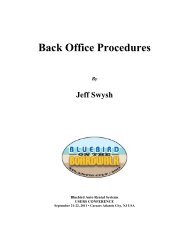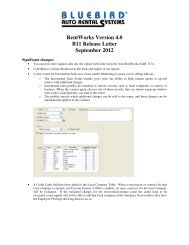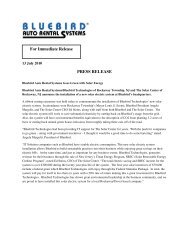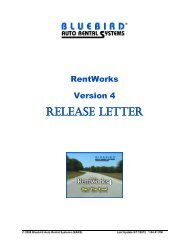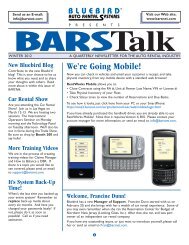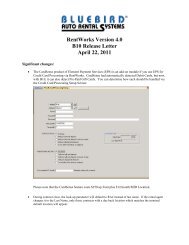time & mileage rates setup - Bluebird Auto Rental Systems Support ...
time & mileage rates setup - Bluebird Auto Rental Systems Support ...
time & mileage rates setup - Bluebird Auto Rental Systems Support ...
You also want an ePaper? Increase the reach of your titles
YUMPU automatically turns print PDFs into web optimized ePapers that Google loves.
RentWorks Time & Mileage Rates Setup GuideSetting Up RatesThere are two parts to a rate. The rate head contains general information about the rate,including the code, fleet class, <strong>mileage</strong> charge, etc. The rate lines give specific <strong>time</strong> ranges and<strong>rates</strong> for calculating charges on the <strong>time</strong> of the rental.When creating a rate, you must specify the location, product, and vehicle class for which thisrate can be used. Once that is set up, you then enter rate lines. A rate line denotes a charge for aspecific <strong>time</strong> period, and when to use this charge.The <strong>time</strong> period for a rate line is defined by the Units and Time Unit fields. Units is thenumber of units of <strong>time</strong> (1, 7, 30, etc.), while Time Unit is the kind of units (minutes, hours,days). The Rate field is the charge per <strong>time</strong> unit for this rate line. In the example rate below, thefirst rate line charges $15.50 for one hour. Period <strong>rates</strong>, such as $100 for 3 days, can be set up ona single rate line by changing the Units and Time Units fields.The Max field is used for tiered <strong>rates</strong>. Multiple rate lines can be set up for the same <strong>time</strong>period, with different maximums for each line. The rate calculation will find the correct rate lineto use, based on the maximum values. An example of a tiered rate is given later on.The Type field is used to distinguish regular rate line from „special‟ rate lines, such asover<strong>time</strong> charges when a vehicle is returned late. An Extra type rate line is used after a largerrate line, in place of the regular line. In the example above, the „XDaily‟ rate line will be usedafter the „Weekly‟ line is used. If the „Weekly‟ line is NOT used, then only the „Daily‟ line willbe used. A 3-day rental with the above rate will have 3 days charged at the „Daily‟ line, while a9-day rental will have 1 „Weekly‟ charge, and 2 „XDaily‟ charges.Value Pricing (VP) gives you the option to calculate the lowest possible charge on a rental,or to calculate strictly by the rate lines used. For example, four hours charged on the „Over<strong>time</strong>‟rate line above comes to $62.00. If Value Pricing is set to „yes‟, then the renter will be chargedan extra „Daily‟ since it is cheaper than four „Over<strong>time</strong>s‟. If Value Pricing is set to „no‟, therenter will be charged the $62.00.A tiered rate is a rate which has more than one daily rate. The Max Units field determineshow many days may be charged on each daily rate line. The Examples section contains anexample on how a tiered rate is usually set up.© 2008 <strong>Bluebird</strong> <strong>Auto</strong> <strong>Rental</strong> <strong>Systems</strong> (BARS) 3




